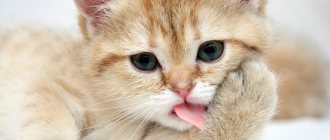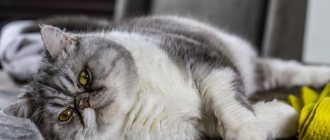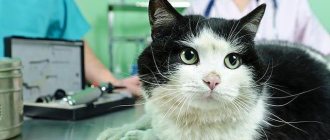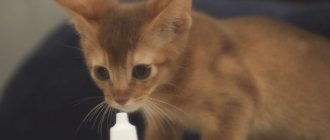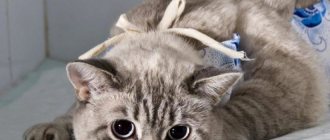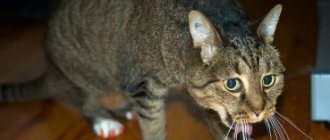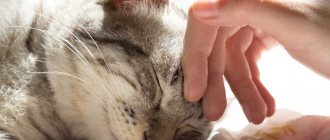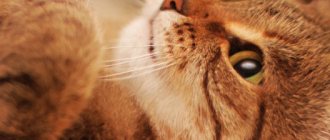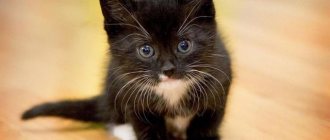The cat is acting restless and not eating anything
Many owners wonder why a cat after giving birth does not want to eat anything and behaves restlessly. And everything is very simple. After the birth of kittens, the animal develops a maternal instinct, and if someone is constantly near her and her offspring, then the cat will not only eat nothing, worrying about her kids, but may even go to the toilet on the carpet in that the room where she is located.
A cat may feel fine after giving birth, but may need help from its owner.
Cats love silence and privacy, so you need to move it with the kittens to a secluded place or cover their box with some kind of sheet and not open it.
For your information! There is no need to visit them every five minutes, because the cat may even show aggression.
This behavior is a completely normal reaction aimed at the protection and health of its offspring.
Features of feeding newborns
If the kittens behave restlessly and squeak frequently, the cat may have a problem with lactation. Perhaps there are too many newborns and they need to be supplemented with a special formula. At the same time, you need to ensure that all kittens receive mother's milk. Sucking kittens stimulates milk production in the cat, so immediately after birth you need to put the babies to the nipples. It happens that in primiparous cats some nipples are inverted. In this case, they need to be carefully massaged and such nipples should be offered to the most active cubs.
You can check the presence of milk in a cat by gently pressing on the nipples, and if milk appears, the kittens, in turn, are calm and actively eating, then everything is fine and there is no need to worry. The first time after birth, it is better to monitor the condition of the cat’s mammary glands. For this purpose, they are examined to ensure that there are no seals or redness.
The weakest babies should be placed on the lowest nipples. If the kittens behave restlessly, and when squeezed out the milk is thick, of an unusual color or with an unpleasant odor, then the children are immediately transferred to artificial feeding. A milk sample is taken from the cat and examined for pathogenic flora. Only a doctor can decide on the further natural feeding of kittens.
The cat is breathing heavily after giving birth
The cat is breathing with its mouth open: what is the reason and what can be done
In general, childbirth in cats is much easier and faster than in dogs, but sometimes there are exceptions. For example, if a cat often breathes with its mouth open after giving birth, this indicates a number of serious health problems, so you should immediately seek medical help from a veterinarian.
Important! After childbirth, breathing may be rapid, but not more than 15 minutes. If shortness of breath with an open mouth occurs much longer, then you should start sounding the alarm.
Reasons for frequent shortness of breath may include:
- inflammatory process in the mammary glands;
- the presence of a dead fetus in the uterus;
- delayed delivery of the placenta;
- eclampsia.
A cat's heavy breathing that continues for a long time should alert you.
If a delay in the release of the placenta has been diagnosed, then after conservative treatment it will come out in the form of lochia for several days, but if not, then surgical intervention is performed.
For your information! The presence of a dead fetus is very dangerous for the animal. In this case, the cat may not survive, so surgery must be performed immediately.
How to properly feed a cat after giving birth
Provide her with constant access to water and food; bowls should be located near the resting place of the cat and her offspring. You need to feed a cat a lot, twice as much as usual: it takes a lot of effort to restore and produce milk. If on the first day after giving birth the cat refuses to eat, do not worry: she has suffered severe stress, and all her attention is focused on the kittens. Your appetite should recover quickly.
If a cat usually eats dry food, then while feeding babies it should be switched to special food for nursing cats, which contains all the necessary minerals, vitamins and nutrients. Such diets are available in the lines of Royal Canin, Eukanuba, Purina Pro Plan, Cat Chow, Brit Care, DailyCat, etc. In addition, these special foods promote milk production.
Subscribe to our newsletter and get a free veterinary consultation
Thanks for subscribing!
Postpartum cat care
The cat is breathing frequently: reasons and how you can help
After a cat has given birth on its own, few people know how to properly care for it. For 12 days after giving birth, small blood clots may still ooze from the cat’s vulva, but the animal takes care of its hygiene on its own. Gradually the discharge will become lighter and stop altogether.
Note! If the animal is sick or has given birth for the first time, then the owner will have to care for her. You need to take a warm, damp towel and wipe the vulva, abdomen and thighs to remove dirt.
From time to time it is necessary to change the dirty litter under the kittens and the cat with clean ones. This should be done when the mustachioed mother has gone to the toilet or gone to eat, so as not to disturb her again. If you are constantly near the offspring, then she may begin to hide the kittens in another place where it is more secluded.
It is important to monitor the condition of the mammary glands so that they are not inflamed or cracked, because as any disease progresses, the offspring will have to be supplemented by hand.
The cat takes care of the kittens, but if it is weakened, then the owner will have to take on some of the worries.
Many owners are interested in the question of what to do with kittens after birth. Since kittens are born blind, it is worth taking care that they are not irritated by bright light. After a cat has chewed the umbilical cord, it should be treated with brilliant green for speedy healing. It is important to monitor the feeding of babies so that their mouth tightly grasps the nipple.
Hygiene and health
After giving birth, the cat’s uterus cleanses itself, so there is a light discharge - about 10-15 days. At first they are reddish, with a small amount of clots, but gradually become lighter.
The owner must carefully monitor not only the secretions themselves, but also the cleanliness of the box where the offspring live.
A cat is a clean animal, and she, as a rule, takes care of her own hygiene, trying not to stain the litter and kittens. However, sometimes she may still need help.
In addition, it is important to monitor the condition of the cat's mammary glands. If redness, suppuration or cracks appear on them, this can lead to breast inflammation. In this case, the cat will need your help: you will need to express milk, make special compresses, and if the disease is in an advanced form, then a course of antibiotics may be required. In any case, the animal must be shown to a veterinarian.
Nutrition during the postpartum period
What to feed a cat after giving birth: proper nutrition and care
After giving birth, it is necessary to give the animal milk, cottage cheese and sour cream, that is, foods rich in calcium. If the body does not have enough of this element, then the pet’s general health may deteriorate, convulsions and postpartum eclampsia may appear.
A cat should eat a variety of foods: meat, fish, chicken eggs. An important source of vitamins is greens, which should also be finely chopped and added to food. If the animal refuses to eat it, then there is no need to force it in, but it is better to purchase special vitamin complexes at the pharmacy.
Nutrition for a mustachioed mother is especially important during this period
For your information! You should definitely increase the amount of fluid you drink. The cat should drink water and also eat soups, broths, etc. The two meals a day should be increased to six times and given in small portions so that the cat has regular milk production.
Postpartum cardiomyopathy
Postpartum cardiomyopathy is one of the most common postpartum pathologies of the cardiovascular system , the exact causes of which still remain unknown. This form of cardiomyopathy usually occurs in the second half of pregnancy. As we have already said, its exact predisposing factors are unknown, and therefore in many cases the disease is considered “idiopathic”.
Many veterinarians suspect that chronic arterial hypertension, mitral stenosis, obesity, viral myocarditis, preeclampsia, anemia, and infectious diseases (especially of a viral nature, since they hit the cardiovascular system hard) may be indirectly to blame.
The incidence of postpartum cardiomyopathy is highly variable. In many situations, clinical signs may well subside some time after birth and not appear until the next pregnancy. In these cases, we can talk about mild damage to the ventricles of the heart. Alas, in more severe situations, the only thing that can save a cat is a heart transplant, which, for obvious reasons, is impossible.
Sometimes it is possible to increase the life expectancy of an animal through well-chosen drug treatment, but one should not particularly hope for its success. To some extent, only timely diagnosis and a competent veterinary cardiologist can improve the prognosis. We hasten to reassure the owners of sick cats to some extent: with high-quality treatment and sterilization (which is highly recommended), your pet will most likely live a long and happy life. But only in cases where you contact your veterinarian on time.
Clinical picture and diagnosis
As a rule, sick animals develop a clinical picture characteristic of typical cases of congestive heart failure. It may include: shortness of breath, cough, tachypnea and cyanosis (blue discoloration of all visible mucous membranes). In addition, the development of edematous phenomena (especially in the lower abdomen), sharp swelling of the jugular vein, as well as weakening of the sounds of heart contractions during auscultation are characteristic.
Ultrasound or fluoroscopic examination often reveals a severe increase in the size of the heart (cardiomegaly). When diagnosing, pathology should be differentiated from pulmonary thromboembolism, pneumonia, amniotic embolism and asthma.
To do this, take into account the following features of the disease:
- When clinical signs appeared - before, immediately after, or within several weeks (months) after the birth of kittens.
- No other causes of heart failure.
- Presence/absence of other heart and vascular diseases before pregnancy.
Very often, cardiomyopathy leads to the development of pulmonary edema . It is caused by poor blood circulation in the pulmonary circulation. When the blood has nowhere to go, its liquid fraction under pressure begins to gradually leak into the pulmonary alveoli.
Signs of edema are quite characteristic: the cat constantly sits with its mouth open, a loud and hoarse bubbling sound comes from the chest, all visible mucous membranes quickly turn blue. Flaky, white foam may be released from the mouth.
If such symptoms appear, the animal must be urgently taken to the nearest clinic, as otherwise it will suffocate.
Therapeutic techniques and important notes
Treatment of cardiac cardiomyopathy in cats is only symptomatic and medicinal. It is no different from therapy in cases of “normal” heart failure. Oxygen masks, a diet with minimal Na and Cl content are indicated, diuretics and vasodilators are prescribed.
If all this is applied in a timely and competent manner, you can achieve very good results and lifelong remission. There is no need to delay treatment, as postpartum cardiomyopathy can cause congestive heart failure, severe heart rhythm disturbances (arrhythmias), thromboembolism and sudden death.
Cats with postpartum cardiomyopathy are at high risk for thrombosis and thromboembolism (due to pregnancy-associated hypercoagulability), as well as hemostasis associated with severe systolic dysfunction. Therefore, if cardiomyopathy is suspected, drugs that reduce blood clotting must be prescribed.
Only an experienced doctor should do this, since otherwise the animal may well die from internal bleeding. Remember that the risk of recurrence of the pathology during a subsequent pregnancy is about 50%. If the animal’s condition improves slowly over several days, it is very advisable to carry out sterilization . Your cat should be taken for a routine veterinary examination at least once a month.
Childbirth in cats is a process that is potentially dangerous due to the possibility of developing various complications. The likelihood of the latter increases sharply in cases where the animal already had health problems before pregnancy. It is for this reason that we would advise taking your pet to the veterinarian at least once a quarter. Prevention is much better than cure.
Recovery period
Since pregnancy and childbirth take a lot of energy from an animal, the recovery period will be long. During this time, many minerals and vitamins are lost, which can result in spinal curvature and spinal deflection.
Pregnancy also has a negative impact on reproductive health, causing the cat to constantly experience hormonal changes. All this greatly depletes the animal, so you need to be patient, monitor proper and balanced nutrition, and then the pet will quickly recover.
Important! Often after giving birth, a cat begins to ask for a cat again, but this should not be allowed; the animal must be provided with peace in order to gain strength and health.
Restoring reproductive health
Pregnancy, subsequent births, care and feeding of kittens do not have the best effect on the cat’s condition. Even in case of good health, she needs time for rehabilitation and restoration of reproductive function.
Curvature of the spine in a cat
The birth of kittens requires significant energy expenditure from the female. Many animals lose weight after giving birth. The formation of embryos, the growth of fetuses, subsequent childbirth and milk feeding lead to the fact that the mother’s body suffers large losses of vitamins and minerals. A characteristic feature of the reproductive period is a deficiency of minerals such as calcium, phosphorus, and magnesium. Often, after the next lambing, a deficiency of mineral substances leads to a change in the skeleton of the pet - deflections of the back are formed, the spine is bent.
Pregnancy and childbirth do not have the best effect on a cat's reproductive health. The animal's body experiences constant hormonal changes. During estrus, estrogens are produced, which stimulate follicle growth and ovulation of eggs. When pregnancy occurs, the female’s body is influenced by the hormone progesterone, which is responsible for the implantation of embryos in the uterus and the normal course of pregnancy. Childbirth is characterized by a sharp increase in the level of oxytocin, which is responsible for contracting the smooth muscles of the uterus and preparing the mammary gland for feeding the offspring. And during feeding, the hormone prolactin is produced.
Such transformations in the body over a short period of time exhaust the animal and can lead to the development of hormonal imbalances. Therefore, a recovery period is required after the next lambing. Experienced owners know that when a cat begins to ask for a cat after giving birth, it is necessary to take measures to prevent pregnancy. The animal must be given sexual rest and measures must be taken to restore strength and health.
Much attention should be paid to mineral nutrition. The animal’s diet during the rehabilitation period should contain increased amounts of calcium, phosphorus, and magnesium
For better absorption of minerals, vitamin supplements should be introduced, especially vitamin D, without which calcium is practically not absorbed into the body. When feeding your pet natural food, you should increase the proportion of dairy products, which are sources of calcium for the body.
A veterinarian will help you select the most effective drug based on a clinical examination of the animal and a biochemical blood test.
What to do if maternal instinct is violated
Maternal instinct in cats may not begin to manifest itself in cats from the first days, especially if she is a primigravida. Also, stress, hormonal and genetic disorders are the cause of poor maternal instinct.
In addition, after a caesarean section, the instinct of motherhood may manifest itself weakly or not at all. Very often the person is to blame for this, because after giving birth he is constantly near the kittens, pushing them out of the box, making noise, picking them up, etc. This should not be done under any circumstances.
Child seat exit delay
The basic sign of this pathology is a sharp rise in body temperature and frequent, sometimes heavy breathing with an open mouth. The cat shows anxiety and may begin to drag newborn babies from the box to other places. In addition, the cat does not want to drink water or eat food. State of depression and depression.
It is advisable to write down their number so as not to miscalculate later, since cats usually eat their afterbirth. A failed placenta is an alarming sign that threatens complications and the development of inflammatory processes in the uterus. Often, delayed placenta becomes the cause of sepsis - blood poisoning.
It is noteworthy that when conducting an ultrasound examination there is no guarantee of detection of the placenta. This is due, first of all, to the size of the uterus, which remains enlarged for some time after birth and may contain blood clots that are mistakenly taken for the placenta that has not been delivered.
Having established the cause of the cat's anxiety, frequent breathing with an open mouth due to retained placenta, conservative therapy is carried out. It consists of taking specific medications that expel the placenta from the uterine cavity. If there is no effect of drug treatment, the uterus and appendages are removed.
Postpartum discharge in cats and care for it
Nature allowed 10 days for complete recovery. Features of this condition:
- discharge lasts from 7 to 21 days;
- When kittens suck milk, the uterus contracts;
- The first discharge is brown or red, but gradually becomes transparent.
What to do during this period:
- In general, the cat takes care of itself, but if you notice stuck pieces of blood in the thigh area, you need to take a wet napkin and wipe it;
- keep the box clean by regularly changing the bedding;
- place the cat and its offspring in a closed place to avoid a stressful situation.
Discharge in cats after birth
Symptoms: normal or pathological
Brown, brown, greenish or reddish discharge in a cat for 2-3 weeks
There is nothing dangerous in this kind of discharge (lochia) from a cat who has given birth, if it:
- last no more than 2–3 weeks;
- not accompanied by fever, vomiting and diarrhea;
- do not have a putrefactive odor;
- look the same all the time, without sudden changes in color, smell or volume.
If the above symptoms are present, you must urgently go to a veterinary clinic for examination and diagnosis.
The cat is breathing quickly or with difficulty
If the cat breathes frequently immediately before or during labor, and this state lasts no more than 5–10 minutes, then everything is fine. If her breathing is difficult for more than 15–20 minutes and her tongue turns blue, then you need to urgently consult a doctor. This may be a sign of heart failure.
Diarrhea and vomiting in a cat before and after birth
Vomiting, drooling, urinating and/or defecating before labor begins is completely acceptable. They develop against the background of an increase in the level of prostaglandins - hormones that cause all smooth muscles in the body to contract. Therefore, in addition to the uterus, the walls of the intestines and bladder can contract. This is the norm. But if such symptoms persist or intensify after the end of labor, you should urgently take the cat to a veterinary clinic.
Constipation after childbirth
If your cat does not have a bowel movement within 24 hours of giving birth, you should consult a doctor. This may be a sign of impaired peristalsis or gastrointestinal tract obstruction.
Lactation disorders in cats
Lactation can begin either a few days before birth or a day after it ends. This process is regulated by sex hormones and depends on their level. Some stimulation of lactation can be irritation of the nipples by babies when sucking. If the mother does not have milk after the birth of the offspring within 2 hours, it is necessary to independently feed the babies with special mixtures. They are sold in veterinary pharmacies and are dosed according to the manufacturer's instructions.
Important: under no circumstances should kittens be given cow's or other milk from the store. It is not absorbed by babies and can lead to weakening of their body and even death.
If lactation has not begun even after 24 hours, the cat should be shown to a doctor.
How can you tell if your cat has enough milk? If the kittens do not squeak much, eat actively, move around and are steadily gaining weight, then there is no need to worry about a lack of milk.
A nursing cat should be given special food for kittens or for pregnant and lactating individuals. Properly selected nutrition is the key to healthy offspring and quick recovery of your pet after childbirth.
If, when feeling the mammary glands, the cat feels pain, is worried, and other signs of pathology of the mammary glands appear, it is necessary to consult a doctor. Usually a gentle massage is sufficient, but in some cases it may be necessary to prescribe medications and wean babies from their mother for artificial feeding.
So, the main cases when a cat or offspring urgently need to be shown to a doctor:
- the condition of the mother or kittens has worsened;
- there is an increase in maternal body temperature above 39.5 C°;
- lochia (discharge) has a pronounced putrid odor, contains pus, and there has been a sharp change in its intensity or character;
- there is vomiting, constipation or diarrhea;
- noticeable breathing difficulties and changes in the color of mucous membranes;
- the cat has prolonged bleeding from the genitals;
- lactation is disrupted or signs of mammary gland pathology are noticeable;
- 4–6 hours after birth, not all the placenta came out (their number, as a rule, is equal to the number of kittens, but there is one placenta (afterbirth) for two babies).
Note: The number of placenta is often difficult to determine correctly, since the female usually eats it. If you are present at the birth, we recommend that you do not allow your cat to eat them to avoid digestive upset.
Dangerous discharge from a cat
If oxytocin was used during labor and the discharge is bright red, then this 100% means tissue rupture, which is a threat to the pet’s life and requires immediate assistance from a veterinarian.
If the discharge is thick with green spots, then this indicates inflammation of the walls of the uterus as a result of infection or incomplete release of the placenta. In this case, treatment with antibiotics or surgery is prescribed.
Discharge of yellow and gray colors means inflammation of the uterus. The disease is dangerous. A high temperature rise occurs, the cat begins to hide, meows heavily and, if inactive, ends in death.
Note! If the affected area is large, the uterus must be removed.
Prevention of complications
To avoid health complications, it is necessary to provide proper care for your cat in advance: clean diapers, boiled water and cotton swabs. It is very important to find a place for lambing, especially if it is a Scottish cat who does not like when any of the people are nearby, he begins to meow and look for a secluded place.
Before giving birth, it is imperative to feed the animal correctly and in a balanced manner so that it is strong and healthy, and then the birth will be quick and easy. It is important to remember that kittens must be born in a sterile environment so that the infection does not penetrate the uterus and cause complications for the new mustachioed mother.
Condition of the kittens
Healthy kittens are usually strong and plump. A caring mother feeds them every two hours. If one of the kittens does not have enough milk, he will definitely tell about it with a shrill squeak.
When too many kittens are born, and the cat’s nutrition leaves much to be desired, several babies may not have enough nutrition at once. Due to prolonged malnutrition, kittens may become weaker. Then for most of the day they will just lie quietly and squeak.
Of course, this state of affairs will have a detrimental effect on their health. Therefore, if for some reason a cat cannot feed her offspring on her own, it is better to transfer the entire litter to artificial feeding. Then the kittens will grow faster and will not stop gaining weight.
At birth, babies usually weigh just over 90 grams. If the cat is healthy and has enough milk, all her babies should gain weight daily. If one of the kittens (or several at once) stops gaining weight, then most likely the feeding is not enough or the baby is simply sick. A healthy kitten's body weight usually increases daily. Babies gain about 10 grams per day.


